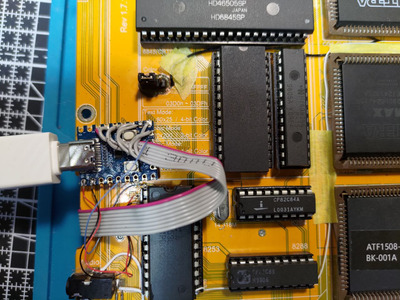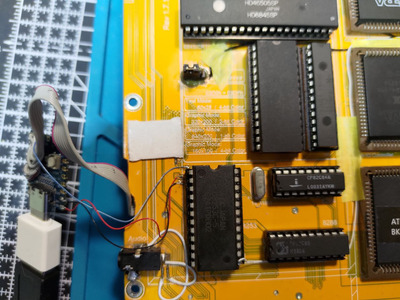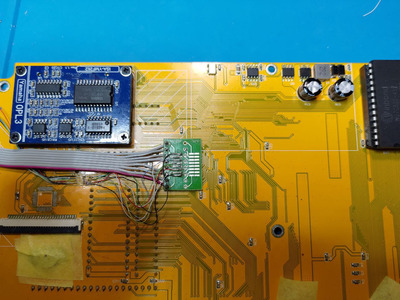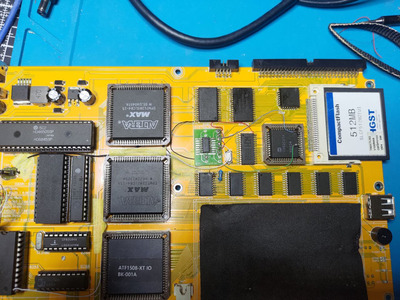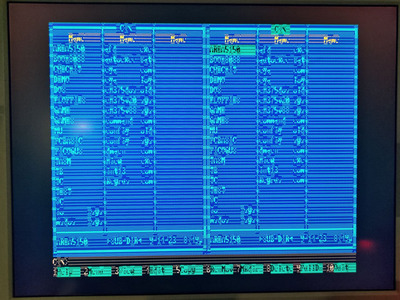pengan wrote on 2023-11-19, 17:00:Hello, it's Pengan here. […]
Show full quote
Hello, it's Pengan here.
Today, I replaced Sergey's BIOS on my Book8088. Currently residing in China, the cost of making BIOS chip here is quite low.
4x Windond W27C512 + 5x ST M27C512 = 83 Yuan.
Additionally, I acquired an ATMega8a EEPROM programmer for 50 yuan.
I haven't purchased a UV eraser yet; a second-hand one might cost around 50 yuan.
In total, it's less than 200 RMB, very cheap. I plan to make some extra chips and give them to my friends who have a Book8088.
Hi Pengan, and welcome!
Thanks for distributing my BIOS 😀
pengan wrote on 2023-11-19, 17:00:
The serial and parallel ports in Book8088 v2 is my suggestion.
Serial and parallel ports are a welcome addition. Here are some more ideas for improvements:
- Add VGA output. Book8088 V2 already uses VGA controller, so it should be fairly straight forward. Potentially, it should be possible to relocate the graphics module closer to the back of the system, and mount the VGA connector on it. I presume that is how serial and parallel ports are implemented.
- Use Flash ROM instead of the EPROM. This would allow for configuration storage, e.g. configuring floppy drive types. Actually, the use of EPROM puzzles me. I think no one makes new UV EPROMs, only OTP EPROMs. Flash ROMs are being manufactured, and quite inexpensive (e.g. SST39SF010A), older no longer manufactured Flash ROMs are also cheaply available. Since the Flash ROM size is typically bigger, e.g. 128 KiB or more, it should be possible to use it to store VGA BIOS as well. If I am not mistaken Cirrus Logic VGA BIOS will work if mapped at 0xE0000. That would allow saving one chip.
- Implement UMBs. This is actually pretty simple. Use two 512 KiB SRAMs (instead of the current 512 KiB + 128 KiB), and map the upper chip to the otherwise unused areas in higher memory, e.g. 0xC8000-0xEFFFF. Ideally the range should be configurable. That might be implemented as a configuration register in the CPLD, or using separate logic and a few dip switches (e.g., see my Xi 8088 implementation, which I believe, Book 8088 was based on).
- Maybe implement an RTC...
Other than that, I think we'll be more than happy to get the schematic for V2 and the CPLD source code, at least for the system CPLD, but I bet people will be interested in the CGA CPLDs too.
pengan wrote on 2023-11-19, 17:00:I am one of the few lucky individuals who have had the opportunity to interact with Shan Zhongyu, also known as the "Hardcore ex […]
Show full quote
I am one of the few lucky individuals who have had the opportunity to interact with Shan Zhongyu, also known as the "Hardcore expert" in person. His vintage PC project has begin in 2017. Here are some of his previous posts that roughly outline his exploration process:
https://www.mydigit.cn/thread-214214-1-1.html
https://www.mydigit.cn/thread-383605-1-1.html
https://www.mydigit.cn/forum.php?mod=viewthread&tid=133380
http://bbs.mydigit.cn/u.php?uid=997328
The first three links seem to be inaccessible, the last one needs registration to read the posts. It would be interesting to see the brief translation of these posts to English.
I did see a video some place in Chinese web site, that presumably was showing a Book 8088 prototype, which was implemented using Faraday FE2010A chipset, likely the design borrowed from my Micro 8088 project.
The video was taken down since... Anyhow Faraday FE2010A is currently pretty expensive, so I can understand why the designer went with the CPLD + 82xx chips instead of a chipset for the current implementation.
pengan wrote on 2023-11-19, 17:00:
Initially, my goal in engaging with him was to join his team. However, I eventually gave up on that. I spent some time attempting to persuade him to provide GPL-compliant BIOS, but unfortunately, I wasn't successful.
...
"Hardcore expert" isn't a member of the open-source community or the retro-computing community. He doesn't have a account on GitHub and isn't familiar with classic DOS games. His vintage computer project stems from a personal passion for electronics. The initial product designs were more geared towards catering to the nostalgia of collectors.
Thanks for trying to convince him to comply with GPL. The rest is a bit puzzling. Why nostalgia collectors would want to get an "old new" hardware?
pengan wrote on 2023-11-19, 17:00:
He invested a lot of effort into dealing with rebuild CGA graphics cards and hacking the firmware of RTD2660 LCD controller to support CGA's 15Khz signal without extra scaler. And all of this is driven by the goal of restoring the "original IBM PC experience."
I guess, for V2 we want it to be reverted to a VGA-compatible firmware... as you might know higher resolution VGA modes don't work well on V2 😉
pengan wrote on 2023-11-19, 17:00:
He believes that many people purchase the Book8088 just to have it as a display piece and might not actually power it on - this is quite common among "collectors" in China. That's also why there's a bit of negligence in both the firmware and the pre-installed software aspects.
Maybe, or maybe he is not a software person, and as you've mentioned previously he was less interested in the vintage computers... that might be a result of lack of knowledge or effort.
pengan wrote on 2023-11-19, 17:00:In the Chinese electronic enthusiast community, I'm a definite minority. I've been living in Canada since 2009 and have attended […]
Show full quote
In the Chinese electronic enthusiast community, I'm a definite minority. I've been living in Canada since 2009 and have attended Vintage Computer Fest and Demoparties(Demosplash, @Party and SynchroNY), but such public events aren't common in China. Most communication is hidden in the deep web, primarily occurring through QQ and WeChat groups.
...
Since meeting "Hardcore expert" back in May, I've been considering writing an article about the Book8088. However, I've realized that I'd almost be writing a paper on cultural conflicts.
In the enthusiast community in China, using open-source code for commercial purposes is seen as shameful because it doesn't allocate benefits to the original authors. Yet, the issue of removed attributions in the Book8088 BIOS is considered tolerable by some because there's no transaction of benefits involved.
This is indeed an act of infringement, and ethically challenging to comprehend, but it does exist. In fact, it permeates even the core ideology of the entire "shanzhai" electronic industry centered around Shenzhen and has achieved significant economic success, despite its controversial nature.
...
"Hardcore expert" Shan Zhongyu's company is based in Guangzhou, and their primary product is engraving machines, also white-labeled. The quality has become quite mature, but they aren't intending to operate under their own brand. They told me that white-labeling saves them branding and legal costs, enabling their products to remain inexpensive - something necessary in the fiercely competitive Chinese market. Initially, he mentioned they only planned to sell Book8088 within China. However, the current situation is that almost all sales are overseas.
Thanks for the cultural background information. Again, since his Book8088 sales are mostly overseas, ideally he should comply with the international copyright law and such. But I do understand that you've already tried to communicate that.
